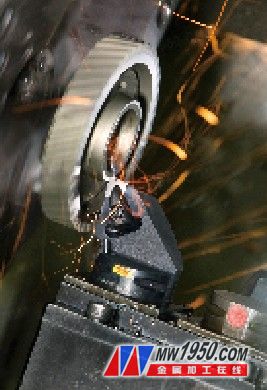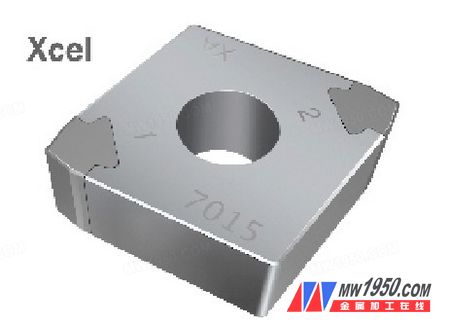[Editor's Note] Machining parts under surface hardening conditions—whether they are hardened or not—helps achieve higher accuracy in a more efficient way. As this process becomes increasingly common, hard part turning has remained a key focus for tool development. Many automotive components require hard machining, such as transmission gears, fuel injection pump nozzles, bearing races, steering gears, brake discs, axles, camshafts, valve seats, pistons, and cylinder liners. Hard machining demands more from cutting tools, making it a challenging but important area of metalworking. Recently, two manufacturers significantly boosted the efficiency of hardened part processing by 116% and 322%, respectively. The secret? They didn’t replace their equipment or adopt new methods. Instead, they simply changed the type of indexable inserts used on their CNC lathes. This new insert design increased the feed rate by three times compared to before, reducing machining time and lowering production costs. The insert that made this possible is the Sandvik Coromant Xcel insert. It allows for higher feed rates while maintaining low surface roughness, marking a breakthrough in hard part turning technology. Its impact has been significant, offering improved performance and reliability in tough machining environments. Requirements for Hard Part Turning Hard part turning requires specific cutting force management. Tools face more pressure than when machining softer materials. Additionally, the abrasive nature of hard workpieces increases tool wear and heat generation. Cubic boron nitride (CBN) tools, second only to diamond in hardness, are ideal for these applications. Today, a range of high-performance CBN-based inserts is available for hard part turning, offering excellent durability and precision. The Xcel insert concept represents a major leap in hard part turning performance. In finishing operations, its ability to maintain surface quality at high feed rates is remarkable. For roughing, it also delivers strong feeding capabilities. When stability is ensured, the Xcel insert can achieve up to 0.5 mm/r feed with sufficient clearance along the shoulder. Pairing it with a Wiper blade that offers twice the feed speed of a standard tool ensures stable and predictable results. For hard part turning, the best approach is to use an Xcel insert for roughing, followed by a Wiper insert with a WG groove for finishing. This combination optimizes both efficiency and surface finish. Key Features of the Xcel Insert The Xcel insert is designed for feed rates between 0.3 to 0.5 mm/r. The recommended maximum depth of cut is 0.25 mm. When using a CNGX insert for shoulder machining, special attention must be given to the geometry: avoid a minimum of 2.7 mm unless there is an undercut. Cutting speeds can reach up to 300 m/min, but the optimal range is usually between 150 and 200 m/min. To maximize productivity, determine the feed rate first, then adjust the cutting speed accordingly. Xcel inserts are ideal for large-diameter shafts, sleeves, and gears, especially in longitudinal and face turning where stability is good. Typical materials include hardened or case-hardened steels like 16MnCr5 (hardness > 60 HRC) or 17CrNiMo6. When machining gears, a hard-soft cutting scenario often occurs, where the outer diameter is 62 HRC and the center is reduced to 30 HRC. CBN is not suitable for materials below 45 HRC, but it can be combined with carbide tools for certain applications. Cutting can be continuous or intermittent, such as in gear teeth or shaft features. Selecting the right insert material helps optimize the process. Surface roughness typically reaches Rz = 1 μm or Ra = 0.25 μm, with dimensional tolerance within 0.01 mm. High feed rates can still produce good surface quality: Ra = 0.3 μm at 0.3 mm/r, Ra = 0.5 μm at 0.4 mm/r, and Ra = 0.8 μm at 0.5 mm/r. Xcel inserts are highly efficient for semi-finishing operations. Hard part turning is now a viable alternative to grinding, with both methods complementing each other. Modern CBN materials offer more durable tools, and advances in blade technology have led to better productivity and finishing capabilities. When using maximum chip thickness as a basis for feed rate, Xcel inserts outperform standard rounded tip blades. With a small lead angle, the thin chips generated by the straight edge enhance productivity and provide more space for cutting. Mechanically locked CBN insert fillets ensure the strength and safety needed for multi-edge inserts, making them cost-effective and reliable. The Safe–Lok multi-fillet technology features a securely welded CBN fillet that keeps it away from the hot cutting zone during hard part turning. Xcel Blade Stability Stability is crucial for all CBN blade applications. To ensure optimal Xcel blade performance, the workpiece aspect ratio should remain within 4:1. Standard round head inserts generate the lowest cutting forces, but feed rates are limited by the relationship between the tool nose radius and surface roughness. Wiper inserts with WH grooves achieve good surface quality at lower feed rates and lower stability requirements. However, at very high feed rates, better surface quality is achieved, though more stability is required. With Xcel inserts, high surface quality is achieved at high feed rates, but stability requirements are also higher. Even at lower feed rates, Xcel inserts deliver good results. The focus is on minimizing cutting time while emphasizing the balance between feed rate and surface roughness. When using a very small lead angle (10°), the depth of cut is always limited during hard part turning. Conventional round head inserts cause varying chip thickness along the cutting edge, but Xcel inserts maintain a uniform, thin chip, enabling high feed processing capability. Tool Life Standard round head inserts suffer from groove abrasion, which limits their life. Xcel inserts, however, distribute wear evenly across the cutting edge, extending tool life. Improved tool life is partly due to shorter contact times, leading to lower temperatures and less diffusion along longer straight edges. As a result, even with higher feed rates, Xcel inserts can process more parts efficiently. Xcel inserts come in two types based on cubic boron nitride (CBN). These materials offer high thermal hardness and resistance to plastic deformation, allowing for higher combinations of feed and cutting speed when machining hardened materials. They also feature good toughness, strength, thermal shock resistance, and abrasive wear resistance. The CBN content ranges from 40% to 65%, with ceramic binders enhancing chemical resistance at elevated temperatures. Some variants use metal binders for higher toughness, catering to different application needs. Diesel Engine Fan Blades,Cooling Fan Blades,Axial Cooling Fan Parts,Engine Cooling Fan Changzhou Keyleader Fan Technology Co. Ltd. , https://www.keyleaderfan.com

Safe–Lok multi-rounded blade